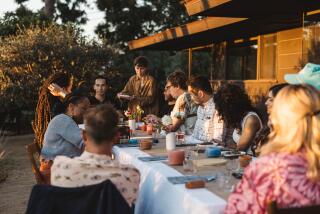Finding inspiration across the room
“Have you ever tried Okinawan sake?”
It wasn’t a question. Not the way the giant Korean dude said it. Not the way he and his band of long-haired, tattooed, well-armed friends stood around grinning like something fun was about to happen, like the haole might just burst into flames after he drank. This wasn’t something I could politely decline. I couldn’t feign an allergy or pat my stomach and say I was full. I was going to try Okinawan sake.
I put on my game face, lifted the glass of clear liquid and took a sip. It had a distinct bouquet, pungent and acrid like a science experiment, but it didn’t taste bad. It wasn’t nearly as rough as the Sonoran tequila I’d had in Hermosillo or the homemade corn whiskey some hillbilly foisted on me in the Ozarks. I smiled at my hosts, the elite undercover narcotic squad of the Honolulu Police Department, and nodded politely. Then, I waited for the punch line.
That came quickly enough, when the bartender, his grin the brightest thing in the room, pulled a large glass jar from behind the bar and revealed the secret ingredient in Okinawan sake. It was a dead snake, about 3 feet long, coiled and marinating at the bottom of a gallon of rice wine; a venomous pit viper called Habu, to be exact, its poison alchemically becoming a kind of “natural Viagra” after a few weeks of soaking in the booze.
As a large Samoan detective began singing in a shimmering, majestic falsetto -- the classic Hawaiian song “Hi’ilawe” -- I ordered a second shot just to see the look on the bartender’s face.
This scene -- the undercover detectives who look like extras from a pirate film, the dank hole-in-the-wall bar in a back alley of Honolulu’s Chinatown, the Michelin Man-sized Samoan singing “Hi’ilawe” -- appears almost verbatim in my second novel “Delicious.”
Not only did the setting work as inspiration, but the stories I heard during late night drinking sessions with the detectives became the jumping-off point for book. And let me just say for the record, for the sake of science, that after three shots of Okinawan sake and a multitude of beers, there was no “Viagra” effect from the Habu venom. You can ask my wife.
I had a similar sort of experience in Bangkok. I was eating breakfast at the Shangri-La Hotel when I noticed a couple: pale, paunchy middle-aged Caucasians dressed head-to-toe in black. The man wore black jeans, a black T-shirt under a black short-sleeved shirt -- who has ever seen a black short-sleeved shirt before? -- with black socks and black shoes. The woman wore a black dress and black sandals.
It was hot, and large black-on-black crescents of sweat grew underneath their arms and down their backs. Even though the breakfast room was indoors, they wore the kind of oversized sunglasses that movie stars or people with dilated pupils hide behind. They both had long, greasy hair that hung over their faces, and they ate without speaking, hunched over their omelets with the defeated air of the permanently hung-over. They must be rock stars in exile, I decided, party animals doomed to wander the earth for eternity.
Not long afterward, Turk Henry, the heavy metal bass player protagonist of my third novel, “Salty,” popped into my head. Inspiration, it seems, can be found at the bottom of a shot of Okinawan rice wine in Honolulu or a bowl of spicy congee in Bangkok.
And that’s the point. People always ask, “How did you come up with that idea?” It’s different for everyone. The drink that inspires me might cause projectile vomiting in someone else. But I think there’s something about traveling, about getting outside your comfort zone, that can make a writer’s antennae pop up. Removed from familiar surroundings and common language, you become more observant than usual, open to new experiences and new people. At the same time, you’re detached, isolated, self-contained and self-aware. It is a similar state of mind to that of writing. As Christopher Isherwood famously said: “I am a camera with its shutter open, quite passive, recording, not thinking.”
The writer-as-camera takes a picture, creates an image or records a moment. A series of seemingly random synapses fire and ideas and words resonate. Sometimes, my brain actually begins to feel like it’s buzzing, and when an idea is really strong, I’ll get goose bumps. Writing a novel is the process of connecting all those random flashes -- the ideas, thoughts and memories -- and turning them into a coherent story so that, hopefully, the reader will experience the same buzz and goose bumps as I did when inspiration first struck.
I don’t get all my inspiration from traveling -- although there are significant tax advantages if you do. But the novel I’m just now starting was triggered when I noticed that parking attendants in Santo Domingo carry shotguns. What’s up with that? I wondered. And in that moment, the story began to be born.
Smith is the author of the novels “Moist,” “Delicious” and “Salty,” which was a Book Sense Notable Book in 2007.
More to Read
The biggest entertainment stories
Get our big stories about Hollywood, film, television, music, arts, culture and more right in your inbox as soon as they publish.
You may occasionally receive promotional content from the Los Angeles Times.










